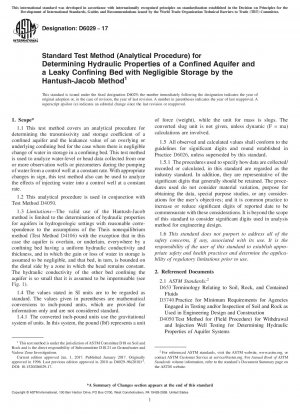ASTM D6029-17
Standard Test Method (Analytical Procedure) for Determining Hydraulic Properties of a Confined Aquifer and a Leaky Confining Bed with Negligible Storage by the Hantush-Jacob Method
- Standard No.
- ASTM D6029-17
- Release Date
- 2017
- Published By
- American Society for Testing and Materials (ASTM)
- Status
- Replace By
- ASTM D6029/D6029M-20
- Latest
- ASTM D6029/D6029M-20
- Scope
- 1.1 This test method covers an analytical procedure for determining the transmissivity and storage coefficient of a confined aquifer and the leakance value of an overlying or underlying confining bed for the case where there is negligible change of water in storage in a confining bed. This test method is used to analyze water-level or head data collected from one or more observation wells or piezometers during the pumping of water from a control well at a constant rate. With appropriate changes in sign, this test method also can be used to analyze the effects of injecting water into a control well at a constant rate. 1.2 This analytical procedure is used in conjunction with Test Method D4050. 1.3 Limitations—The valid use of the Hantush-Jacob method is limited to the determination of hydraulic properties for aquifers in hydrogeologic settings with reasonable correspondence to the assumptions of the Theis nonequilibrium method (Test Method D4106) with the exception that in this case the aquifer is overlain, or underlain, everywhere by a confining bed having a uniform hydraulic conductivity and thickness, and in which the gain or loss of water in storage is assumed to be negligible, and that bed, in turn, is bounded on the distal side by a zone in which the head remains constant. The hydraulic conductivity of the other bed confining the aquifer is so small that it is assumed to be impermeable (see Fig. 1). 1.4 The values stated in SI units are to be regarded as standard. The values given in parentheses are mathematical conversions to inch-pound units, which are provided for information only and are not considered standard. 1.4.1 The converted inch-pound units use the gravitational system of units. In this system, the pound (lbf) represents a unit of force (weight), while the unit for mass is slugs. The converted slug unit is not given, unless dynamic (F = ma) calculations are involved. 1.5 All observed and calculated values shall conform to the guidelines for significant digits and round established in Practice D6026, unless superseded by this standard. 1.5.1 The procedures used to specify how data are collected/ recorded or calculated, in this standard are regarded as the industry standard. In addition, they are representative of the significant digits that generally should be retained. The procedures used do not consider material variation, purpose for obtaining the data, special purpose studies, or any considerations for the user’s objectives; and it is common practice to increase or reduce significant digits of reported date to be commensurate with these considerations. It is beyond the scope of this standard to consider significant digits used in analysis method for engineering design. 1.6 This standard does not purport to address all of the safety concerns, if any, associated with its use. It is the responsibility of the user of this standard to establish appropriate safety and health practices and determine the applicability of regulatory limitations prior to use.
ASTM D6029-17 Referenced Document
- ASTM D3740 Standard Practice for Minimum Requirements for Agencies Engaged in the Testing and/or Inspection of Soil and Rock as Used in Engineering Design and Construction
- ASTM D4050 Standard Test Method for (Field Procedure) for Withdrawal and Injection Well Tests for Determining Hydraulic Properties of Aquifer Systems
- ASTM D4106 Standard Test Method for (Analytical Procedure) for Determining Transmissivity and Storage Coefficient of Nonleaky Confined Aquifers by the Theis Nonequilibrium Method
- ASTM D6026 Standard Practice for Using Significant Digits in Geotechnical Data
- ASTM D6028 Standard Test Method (Analytical Procedure) for Determining Hydraulic Properties of a Confined Aquifer Taking into Consideration Storage of Water in Leaky Confining Beds by Modified Hantush Method
- ASTM D653 Standard Terminology Relating to Soil, Rock, and Contained Fluids
ASTM D6029-17 history
- 2020 ASTM D6029/D6029M-20 Standard Practice for (Analytical Procedures) Determining Hydraulic Properties of a Confined Aquifer and a Leaky Confining Bed with Negligible Storage by the Hantush-Jacob Method
- 2017 ASTM D6029-17 Standard Test Method (Analytical Procedure) for Determining Hydraulic Properties of a Confined Aquifer and a Leaky Confining Bed with Negligible Storage by the Hantush-Jacob Method
- 1996 ASTM D6029-96(2010)e1 Standard Test Method (Analytical Procedure) for Determining Hydraulic Properties of a Confined Aquifer and a Leaky Confining Bed with Negligible Storage by the Hantush-Jacob Method
- 1996 ASTM D6029-96(2004) Standard Test Method (Analytical Procedure) for Determining Hydraulic Properties of a Confined Aquifer and a Leaky Confining Bed with Negligible Storage by the Hantush-Jacob Method
- 1996 ASTM D6029-96 Standard Test Method (Analytical Procedure) for Determining Hydraulic Properties of a Confined Aquifer and a Leaky Confining Bed with Negligible Storage by the Hantush-Jacob Method
